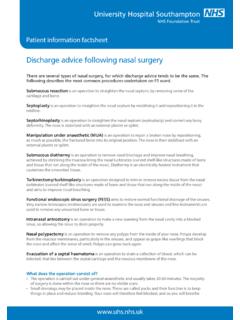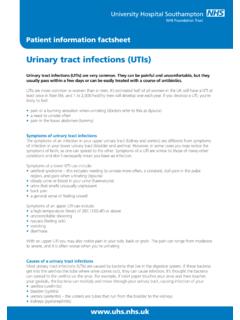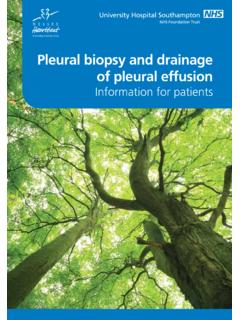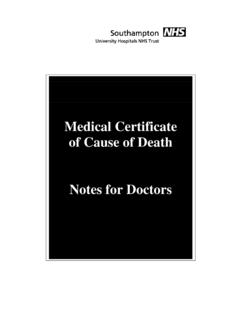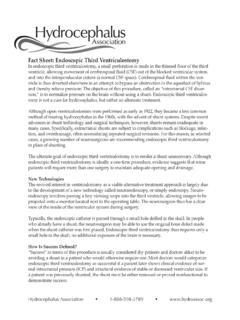Transcription of Patient information factsheet - uhs.nhs.uk
1 Patient information factsheet Leg artery bypass (fem-pop bypass). The femoral artery runs down from the groin and into the thigh. This artery delivers blood to your legs. When the femoral artery reaches the back of the knee it becomes the popliteal artery and runs into the smaller arteries which run below the calf and into the foot. When there is a blockage in any of these arteries, the circulation of blood to your leg is reduced which may cause you to have pain in your calf when you walk. This is known as intermittent claudication. In severe cases the blood supply can be reduced to such an extent that you experience pain all the time in the foot (rest pain). Equally, due to poor blood flow trivial injuries do not heal and form ulcers or toes turn black after minor knocks (tissue loss).
2 In this situation surgery is needed to relieve symptoms and save the leg. The surgery An arterial bypass (also known as a fem-pop bypass) is an operation to create a new route for blood to get into the leg. The bypass is usually made using a piece of another blood vessel (a vein). During the operation a number of small cuts are made on the leg. These allow the surgeon to expose the healthy artery above and below the blockage. The skin cuts also allow the vein in the leg to be removed such that it can be used as the bypass. The vein is plumbed into the healthy portions of artery and the blood can then travel into the foot. Any decision on treatment will be carefully considered by your vascular multidisciplinary team and discussed in detail with you. surgery should improve your symptoms and allow any wound or ulcer to heal.
3 What are the risks of treatment? As with any operation there are risks involved which vary according to your health but typically include: Fluid leak from wound (common): Occasionally the wound may leak fluid. This may be clear but is usually blood stained. It normally settles in time, and does not usually indicate a problem with the bypass itself. Limb swelling (common): It is normal for the leg to swell after this operation. The swelling usually lasts for about two to three months. It normally goes almost completely, but may occasionally persist indefinitely. Skin sensation (common): You may have patches of numbness around the wound or lower down the leg which is due to the inevitable cutting of small nerves to the skin. This can be permanent, but usually gets better within a few months.
4 Wound infection (common): Wounds sometimes become infected and this may need treatment with antibiotics. Occasionally, the incision may need to be cleaned out under anaesthetic. Patient information factsheet Bypass blockage (uncommon): The main complication of this operation is blood clotting within the bypass causing it to block. If this occurs it will usually be necessary to perform another operation. The durability of a graft is improved by stopping smoking and exercising. Limb loss (rare): Very occasionally when the bypass blocks and the circulation cannot be restored, the circulation of the foot is so badly affected that amputation is required. Risk to life (rare): As with any major operation there is always a risk to life. This is usually extremely small but is partially dependent on your age, weight and general health.
5 We will be happy to discuss these risks with you, or answer any questions that you may have. Are there any alternatives to this treatment? Depending on the location of blockage it is sometimes possible to perform an angioplasty. This is where a wire is passed into the artery so it can be stretched and if needed a stent (small wire tube) placed. This may not be successful or may not be a suitable option. If you don't receive any treatment, your symptoms will not improve and are likely to worsen. In some cases amputation is required if the blood supply to the leg is completely blocked. Consent We must seek your consent for any procedure or treatment before it can go ahead. Your medical team will explain the risks, benefits and alternatives where relevant before they ask for your consent.
6 If you are unsure about any aspect of the procedure or treatment proposed, please do not hesitate to ask for more information . Before your surgery Preparing for your operation Smoking is a major risk for arterial disease, increases the chances of getting a chest infection and slows your recovery. So if you're a smoker, you need to stop. The NHS Quitters service is available to help support you. You can contact them on 0300 123 3791 or visit You can also talk to your GP who can prescribe nicotine replacement for you. Exercise can boost your immune system and help your recovery so try gentle exercise, such as walking and cycling. Thinking about your return home Before your operation, it's a good idea to start thinking about how you will manage at home after your surgery .
7 We encourage patients to stay with family or friends or to have a relative staying with them if possible. If you live alone or require additional support then we may need to help you make plans for a short period before you go home. The sooner we know this, the sooner we can start arranging something for you. Talk to your close family, friends and GP to see what options you have. You will need to be collected from hospital on the day you are discharged so, before you come into hospital, you should arrange who will collect you. It's also worth asking someone to get you fresh food so you have something at home when you leave hospital. Patient information factsheet Pre-assessment Before you are admitted for surgery you will be seen by a specialist nurse and an anaesthetist in clinic.
8 We'll take a detailed medical history, as well as perform blood tests, a physical examination, blood pressure checks and a heart trace (ECG). The anaesthetist will talk to you about your anaesthetic and how your pain will be controlled. You should bring in a list of the medications you take and when you take them. We'll let you know if you need to make any changes to your medication for your surgery . You will also be asked to fill in a questionnaire for the therapy team to help identify if you may need any help or support after the operation. If you do then a member of the therapy team may contact you before you come into hospital. You will also be given information on local services which may be useful to you. Coming into hospital What to bring When you come into hospital there are a few items that you should bring: All your medications (including insulins and inhalers).
9 Nightwear and changes of clothes Toiletries Dentures, glasses and hearing aids if you have them Bring them in a small bag labelled with your name. There isn't much storage space on the ward so it should only be a small bag. We recommend that you leave valuable items at home; especially as you'll be asked to remove jewellery prior to surgery . The ward cannot accept responsibility for items left on the ward and not handed to the cashiers for safe keeping. What to expect during your stay in hospital Prior to surgery you will be assessed to ensure nothing has changed. You may need to have further blood tests. On the day of surgery you will be taken to theatre where your details will be checked before you're taken to the anaesthetic room and then into surgery . After theatre you will usually return to the ward.
10 If you require observation you will be taken to the high dependency unit. Your anaesthetist will tell you if this is necessary. You may have a number of special tubes initially which will be removed as you recover: A drip to give you fluids directly into a vein. Wound drain a tube into your leg so that any old blood (haematoma) can drain away. It is removed when the drainage has stopped. Urinary catheter a tube into your bladder to drain urine. The drainage is measured closely by the staff. PCA A PCA ( Patient controlled analgesia) is a special drip that goes through a pump to give you pain relief. Your pulse, blood pressure, temperature, breathing rate and pulse will be monitored. Patient information factsheet Pain The wound in your leg is likely to be uncomfortable at first.
